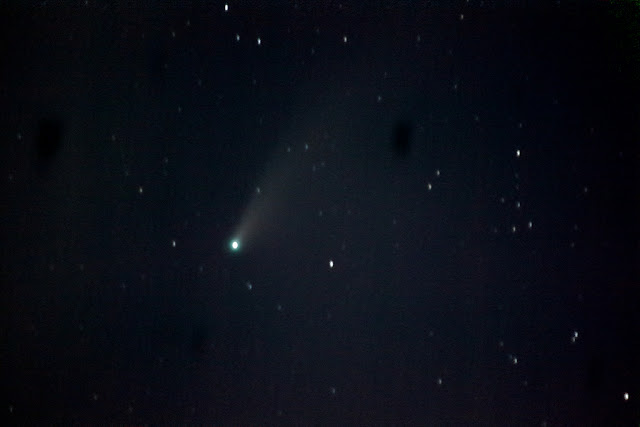Comet NEOWISE became a pretty popular name among stargazers as well as non-stargazers in 2020. One of the main reasons why it was so popular was that it was one of the brightest comets in about 13 years (since the comet C/2006 P1 (McNaught) - which was a daylight comet as well). Unlike for example the 9 comets that turned up in 2019 or the 19 that turned up in 2018 - which clearly not many knew about, NEOWISE was a naked eye comet.
When I heard of NEOWISE, it was just swinging past the Sun. The perihelion of it was on 3rd July and by that time it has already become suitable for naked eye observations. However this is a horrible time for Sri Lankan stargazers as we are going through a monsoon period. Weather can be very unpredictable and the sky is always cloudy. On July 11th, me and a friend tried to venture out to an area we thought would be relatively cloudless, only to figure out half way that it's going to be pouring buckets. I had almost given up the idea of spotting this comet.
By 20th of July however, things got better. Dumidu Padeniya became the first person to photograph the comet from Sri Lanka itself (afaik). With a renewed interest, I decided to travel nearly 400km and a 9hr train journey.
My first attempt to capture it on the evening of 24th July was unsuccessful. But it seemed like, two others in Sri Lanka managed successfully capture it again.
As it turned out, my luck was to come on the evening of 25th of July. The weather reports turned out to be pretty favourable, but as anyone who is involved in astronomy know, weather reports mean nothing unless you can actually see it. Thankfully, the sky seemed to be actually clear too.
One of the issues with what you can see in the sky vs. what it actually is, is that the human eye cannot discern the actual level of clouds and cannot estimate the effect of the glow/glaze until you actually see it. My first photo of the NEOWISE was a taken out of complete despair and when I was ready to turn back.
 |
| Canon 550D - 18mm: single shot of 10s @ ISO400 |
Once I figured that there the camera could see it even if I couldn't I started blind-shooting it. I don't think there is actually a term called blind shooting. To me it simply means that I can't see what I am shooting, and I have to focus and track it after each shot, looking at the photo in the camera.
 |
| Canon 550D - 55mm: stack of 10 photos of 5s @ ISO1600 |
Needless to say that the outcomes are quite far from what they should be. However I managed to compile another shot from the photos taken at 300mm which gives a little bit more details.
 |
| Canon 550D - 300mm: stack of 10 photos of 6s @ ISO 3200 |
Since I am not using a tracking mount and a pretty noisy photo, DeepSkyStacker (the program I am using) has issues identifying stars to to stack multiple images. Above one was created after multiple trials and errors. However now that I do have the source files captured, I do plan to try and see if I can stack them with an alternative. This could probably mean that I would end up manually stacking them. However, no promises.
There is a long way to go for me in astrophotography. But I am glad that I was able to capture on photo what I could not see. To the date, I have not seen the comet with my naked eyes. Not even with a binocular.


Comments
Post a Comment